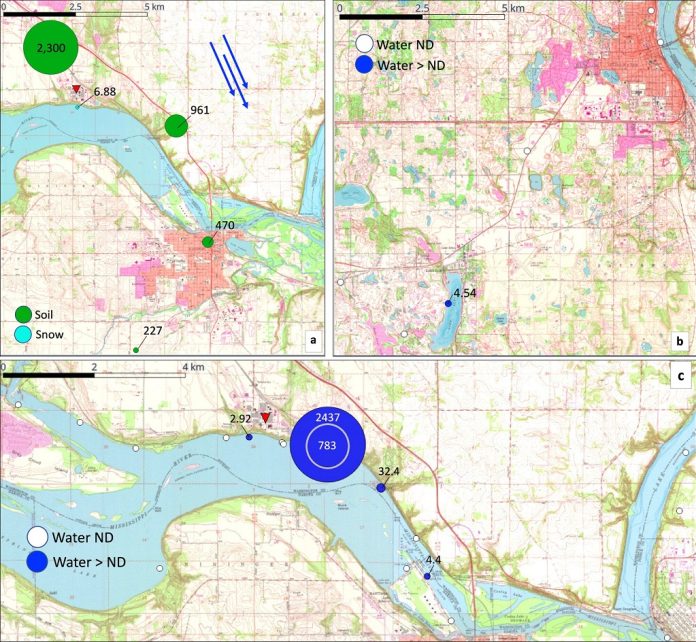PFAS FOREVER CHEMICALS
By Knowridge
-July 10, 2024

Minnesota field data. Credit: Nature Communications (2024).
A new study has revealed that lithium-ion batteries, essential for electric cars and electronic devices, are contributing to growing pollution from per- and polyfluoroalkyl substances (PFAS).
The research, which includes work from Texas Tech University’s Jennifer Guelfo, highlights the environmental impact of a specific PFAS sub-class used in these batteries.
Published in Nature Communications, the study found that these PFAS, called bis-perfluoroalkyl sulfonimides (bis-FASIs), persist in the environment and are toxic, similar to well-known harmful compounds like perfluorooctanoic acid (PFOA).
Lithium-ion batteries are crucial for the clean energy movement, but their widespread use brings unintended consequences.
Jennifer Guelfo, an associate professor of environmental engineering, stated, “Reducing carbon dioxide emissions with technologies like electric cars is essential, but it shouldn’t lead to increased PFAS pollution.
We need better manufacturing, disposal, and recycling practices to tackle climate change without releasing these persistent pollutants.”
The research team sampled air, water, snow, soil, and sediment near manufacturing plants in the U.S. (Minnesota and Kentucky) and Europe (Belgium and France). They found high levels of bis-FASI in these samples. Data also suggested that bis-FASI can travel long distances through the air, affecting areas far from the original pollution sources. Samples from municipal landfills in the southeastern U.S. indicated that these compounds can enter the environment when products, including lithium-ion batteries, are disposed of.
Toxicity tests showed that the bis-FASI levels found in the environment could alter behavior and energy metabolism in aquatic organisms. While the effects on humans are not yet studied, other PFAS are known to cause cancer, infertility, and other serious health problems.
The study also examined how to treat water contaminated with bis-FASI. They found that traditional methods, like using granular activated carbon and ion exchange, can reduce bis-FASI levels in water. These methods are already used to remove other PFAS from drinking water.
Lee Ferguson, a study author and associate professor of environmental engineering at Duke University, explained, “Our findings show that treatment methods designed for other PFAS can also remove bis-FASI. As treatment facilities upgrade to meet new EPA standards, these approaches will likely become more common.”
Both Guelfo and Ferguson stress the importance of adopting clean energy technologies that do not harm the environment. Ferguson said, “We need teams of scientists, engineers, sociologists, and policymakers to work together to promote clean energy while minimizing its environmental impact.”
Guelfo added, “We should use the momentum behind current energy initiatives to ensure that new technologies are genuinely clean and sustainable.”
In summary, while lithium-ion batteries play a vital role in reducing carbon emissions, they also pose a pollution risk due to bis-FASI. This study calls for improved practices to ensure that clean energy technologies do not create new environmental problems.
A new study has revealed that lithium-ion batteries, essential for electric cars and electronic devices, are contributing to growing pollution from per- and polyfluoroalkyl substances (PFAS).
The research, which includes work from Texas Tech University’s Jennifer Guelfo, highlights the environmental impact of a specific PFAS sub-class used in these batteries.
Published in Nature Communications, the study found that these PFAS, called bis-perfluoroalkyl sulfonimides (bis-FASIs), persist in the environment and are toxic, similar to well-known harmful compounds like perfluorooctanoic acid (PFOA).
Lithium-ion batteries are crucial for the clean energy movement, but their widespread use brings unintended consequences.
Jennifer Guelfo, an associate professor of environmental engineering, stated, “Reducing carbon dioxide emissions with technologies like electric cars is essential, but it shouldn’t lead to increased PFAS pollution.
We need better manufacturing, disposal, and recycling practices to tackle climate change without releasing these persistent pollutants.”
The research team sampled air, water, snow, soil, and sediment near manufacturing plants in the U.S. (Minnesota and Kentucky) and Europe (Belgium and France). They found high levels of bis-FASI in these samples. Data also suggested that bis-FASI can travel long distances through the air, affecting areas far from the original pollution sources. Samples from municipal landfills in the southeastern U.S. indicated that these compounds can enter the environment when products, including lithium-ion batteries, are disposed of.
Toxicity tests showed that the bis-FASI levels found in the environment could alter behavior and energy metabolism in aquatic organisms. While the effects on humans are not yet studied, other PFAS are known to cause cancer, infertility, and other serious health problems.
The study also examined how to treat water contaminated with bis-FASI. They found that traditional methods, like using granular activated carbon and ion exchange, can reduce bis-FASI levels in water. These methods are already used to remove other PFAS from drinking water.
Lee Ferguson, a study author and associate professor of environmental engineering at Duke University, explained, “Our findings show that treatment methods designed for other PFAS can also remove bis-FASI. As treatment facilities upgrade to meet new EPA standards, these approaches will likely become more common.”
Both Guelfo and Ferguson stress the importance of adopting clean energy technologies that do not harm the environment. Ferguson said, “We need teams of scientists, engineers, sociologists, and policymakers to work together to promote clean energy while minimizing its environmental impact.”
Guelfo added, “We should use the momentum behind current energy initiatives to ensure that new technologies are genuinely clean and sustainable.”
In summary, while lithium-ion batteries play a vital role in reducing carbon emissions, they also pose a pollution risk due to bis-FASI. This study calls for improved practices to ensure that clean energy technologies do not create new environmental problems.

No comments:
Post a Comment